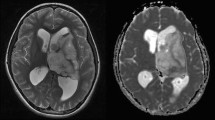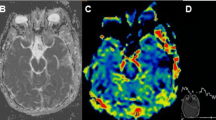Abstract
Glioblastoma multiforme (GBM) are morphologically heterogeneous tumors, with varying amounts of necrosis, and edema. Previous studies have shown that treatments incorporating the VEGF antibody bevacizumab can reduce edema and tumor burden in GBM. Additionally it has been suggested that bevacizumab regimen treatment reduces the percent of tumoral necrosis. Therefore we sought to (1) determine the time course of change in necrosis, tumor, and edema volume in patients who respond to bevacizumab regimen treatment and (2) determine if GBM that progress following a response to bevacizumab regimen treatment are morphologically different from their appearance at prior tumor progression. Therefore, we retrospectively assessed tumor, necrosis, and edema volumes on MRI scans from 15 patients with recurrent GBM who responded to bevacizumab regimen treatment, and had extended (>7 month) follow-up. We found that the median time to best tumor response was 158 days (range, 16–261, SD = 63). The median best response was 72.1% reduction in tumor volume and 72.8% reduction in peritumoral edema. Most tumors (77.8%) showed resolution of necrotic areas. The relative reduction of edema and necrosis was sustained, even in patients (n = 7) who developed tumor progression. Thus the mean ratio of edema-to-tumor volume at progression on bevacizumab regimen treatment was 38.4% lower than that for the same tumors seen on progression scans following prior chemotherapy. The percentage of necrotic tumor also was diminished following progression on bevacizumab regimen treatment. These findings illustrate the time course of changes in edema and tumor volume with prolonged bevacizumab regimen treatment, and support the conclusion that the morphology of recurrent GBM following bevacizumab regimen therapy is distinct from that on other chemotherapy.





Similar content being viewed by others
Abbreviations
- GBM:
-
Glioblastoma multiforme
- VEGF:
-
Vascular endothelial growth factor
- MRI:
-
Magnetic resonance imaging
- TTR:
-
Time to partial tumor response
- TTP:
-
Time to tumor progression
- RT:
-
Radiation therapy
- RECIST:
-
Response evaluation criteria in solid tumors
References
Stupp R, Mason WP, van den Bent MJ et al (2005) Radiotherapy plus concomitant and adjuvant temozolomide for GBM. N Engl J Med 352:987–996
Huang H, Held-Feindt J, Buhl R et al (2005) Expression of VEGF and its receptors in different brain tumors. Neurol Res 27(4):371–377
Hicklin DJ, Ellis LM (2005) Role of the vascular endothelial growth factor pathway in tumor growth and angiogenesis. J Clin Oncol 23:1011–1027
Pope WB, Sayre J, Perlina A et al (2005) MR imaging correlates of survival in patients with high-grade gliomas. Am J Neuroradiol 26:2466–2474
Rong Y, Durden DL, Van Meir EG, Brat DJ (2006) ‘Pseudopalisading’ necrosis in glioblastoma: a familiar morphologic feature that links vascular pathology, hypoxia, and angiogenesis. J Neuropathol Exp Neurol 65(6):529–539
Zhou YH, Tan F, Hess KR, Yung WK (2003) The expression of PAX6, PTEN, vascular endothelial growth factor, and epidermal growth factor receptor in gliomas: relationship to tumor grade and survival. Clin Cancer Res 15:3369–3375
Lacroix M, Abi-Said D, Fourney DR et al (2001) A multivariate analysis of 416 patients with glioblastoma multiforme: prognosis, extent of resection, and survival. J Neurosurg 95(2):190–198
Duda DG, Batchelor TT, Willett CG et al (2007) VEGF-targeted cancer therapy strategies: current progress, hurdles and future prospects. Trends Mol Med 13(6):223–230
Pope WB, Lai A, Nghiemphu P et al (2006) MRI in patients with high-grade gliomas treated with bevacizumab and chemotherapy. Neurology 66:1258–1260
Vredenburgh JJ, Desjardins A, Herndon JE et al (2007) Phase II trial of bevacizumab and irinotecan in recurrent malignant glioma. Clin Cancer Res 13(4):1253–1259
Rees JH, Smirniotopoulos JG, Jones RV, Wong K (1996) Glioblastoma multiforme: radiologic-pathologic correlation. Radiographics 16:1413–1438
Sorenson AG, Patel S, Harmath C et al (2001) Comparison of diameter and perimeter methods for tumor volume calculation. J Clin Oncol 19:551–557
Galanis E, Buckner JC, Maurer MJ et al (2006) Validation of neuroradiologic response assessment in gliomas: measurement by RECIST, two-dimensional, computer-assisted tumor area, and computer-assisted tumor volume methods. Neuro-Oncology 8:156–165
Shah GD, Kesari S, Xu R, Batchelor TT, O’Neill AM, Hochberg FH, Levy B, Bradshaw J, Wen PY (2006) Comparison of linear and volumetric criteria in assessing tumor response in adult high-grade gliomas. Neuro-Oncology 8:38–46
Therasse P, Arbuck SG, Eisenhauer EA et al (2000) New guidelines to evaluate the response to treatment in solid tumors. J Natl Cancer Inst 92:205–216
Therasse P (2002) Evaluation of response: new and standard criteria. Eur Soc Ann Oncol 13(Suppl 4):127–129
Cloughesy TF, Filka E, Kuhn J et al (2003) Two studies evaluating irinotecan treatment for recurrent or progressive malignant glioma. Cancer 97:2381–2386
Wong ET, Hess KR, Gleason MJ (1999) Outcomes and prognostic factors in recurrent glioma patients enrolled onto phase II clinical trials. J Clin Oncol 17:2572–2578
de Wit MCY, de Bruin HG, Eijkenboom W, Sillevis-Smitt PAE, van den Bent MJ (2004) Immediate post-radiotherapy changes in malignant glioma can mimic tumor progression. Neurology 63(535):537
Gonzalez J, Kumar AJ, Conrad CA, Levin VA (2006) Effect of bevacizumab on radiation necrosis of the brain. Int J Radiat Oncol Biol Phys 67:323–326
Jensen RL, Ragel BT, Whang K, Gillespie D (2006) Inhibition of hypoxia inducible factor-1alpha (HIF-1alpha) decreases vascular endothelial growth factor (VEGF) secretion and tumor growth in malignant gliomas. J Neurooncol 78(3):233–247
Korkolopoulou P, Patsouris E, Konstantinidou AE et al (2004) Hypoxia-inducible factor 1alpha/vascular endothelial growth factor axis in astrocytomas. Associations with microvessel morphometry, proliferation and prognosis. Neuropathol Appl Neurobiol 30(3):267–278
Carlson MRJ, Pope WB, Horvath S et al (2007) Relationship between survival and edema in malignant gliomas: role of vascular endothelial growth factor and neuronal pentraxin 2. Clin Cancer Res 13(9):2592–2598
Author information
Authors and Affiliations
Corresponding author
Rights and permissions
About this article
Cite this article
Ananthnarayan, S., Bahng, J., Roring, J. et al. Time course of imaging changes of GBM during extended bevacizumab treatment. J Neurooncol 88, 339–347 (2008). https://doi.org/10.1007/s11060-008-9573-x
Received:
Accepted:
Published:
Issue Date:
DOI: https://doi.org/10.1007/s11060-008-9573-x




